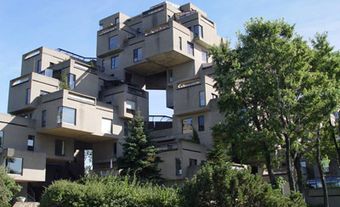Norbert Schoenauer
Norbert Schoenauer, educator, architect, housing reformer (b at Regen, Romania 2 Jan 1923; d at Montréal 7 Aug 2001). Schoenauer devoted his career to the understanding and improvement of housing design. Following his graduation in 1945 with a Bachelor of Architecture from the Royal Hungarian Technical University in Budapest, Schoenauer relocated to Copenhagen. There he earned a certificate in ARCHITECTURE from the Royal Academy of Fine Arts in 1950. He came to Canada in 1951 and eventually settled in Montréal. He graduated with a Masters of Architecture from McGill University in 1959. The following year he joined the faculty of the school of architecture at McGill University, where he taught for more than four decades.
Schoenauer's position at the university drew together his teaching, writing and practice. He taught architectural design based on wide knowledge and firsthand experience with housing typologies around the world. He believed mixed-use, high-density, mid-rise housing would ensure better cities. "A house should be no taller than a tree," he told generations of students, explaining that at such a scale (about 60 feet) a mother could still see her children playing outside.
Schoenauer's courses at McGill were legendary and inspired several of his book projects. His most important publication, the three-volume 6000 Years of Housing published in 1981, resulted from his lectures on the history of housing. The book was updated and republished as a single volume by W.W. Norton in 2000, and was translated into Spanish and Japanese. Between his first book, The Court-Garden House (1962), written with Stanley Seeman, and his last one, Cities, Suburbs, Dwellings in the Postwar Era (1994), Schoenauer argued for a more humane urban house, largely based on European modernist precedents.
In addition to this dynamic relationship between his teaching and writing, Schoenauer's professional work as an architect and planner directly inspired his ideas for housing reform. Projects carried out in association with Montréal architects Affleck, Desbarats, Dimakopoulos, Lebensold and Sise included the Chomedey Civic Centre and the Confederation Memorial Building in Charlottetown; both won first prizes in national competitions in the early 1960s. Schoenauer worked with long time partner Maurice Desnoyers on the Master Plan and Housing for the new iron-ore town of Fermont, Qué. An influential model for industrial towns around the world, Fermont illustrated many of the tenets Schoenauer espoused in his teaching: a compact plan to minimize the cost of infrastructure, wind-shielding architecture to combat the sub-arctic climate, and a pedestrian link to all community facilities.
Other important projects include an early master plan for Nuns Island (with Seeman and Victor PRUS, 1963), Woodroffe, Ont (1973); Village de l'Anse (with Desnoyers) in Québec City (1972); and Hillside housing in Westmount (with Desnoyers, 1974).
Schoenauer's contributions to architectural education and practice were recognized with numerous honours. The Order of Architects of Quebec awarded him La Medaille du Mérite for 1995, and the Association of Collegiate Schools of Architecture named him a distinguished professor in 1999. He was a fellow of the Royal Architectural Institute of Canada and academician of the Royal Canadian Academy, and his professional memberships included the Order of Architects of Quebec, the Corporation professionelle des urbanistes du Québec, and the Canadian Institute of Planners. In addition to his two-year term as executive director in 1975-77, he served the Canada Mortgage and Housing Corporation as senior advisor on planning and design, and represented Canada on numerous missions for the United Nations and other international organizations.
Schoenauer's books, papers, and photographs are now part of the Blackader-Lauterman Library of Architecture and Art and the John Bland Canadian Architecture Collection at McGill University. A special issue of ARQ (Architectural Research Quarterly, Feb 2003) explores his multifaceted career.

 Share on Facebook
Share on Facebook Share on X
Share on X Share by Email
Share by Email Share on Google Classroom
Share on Google Classroom

